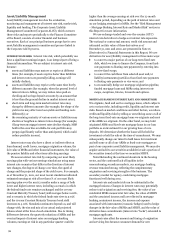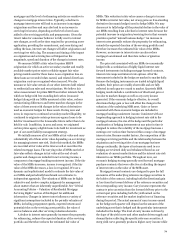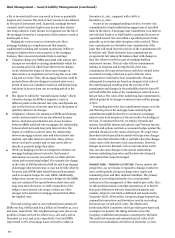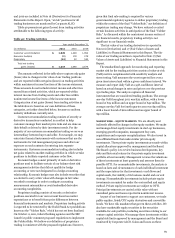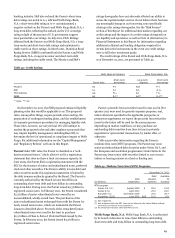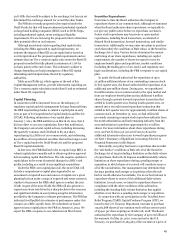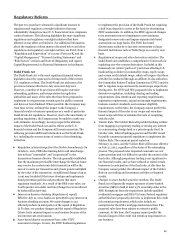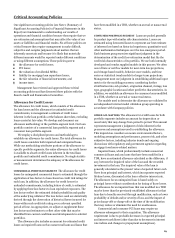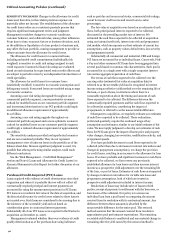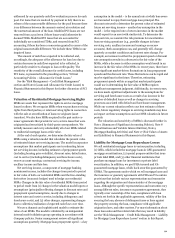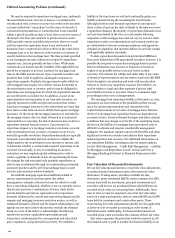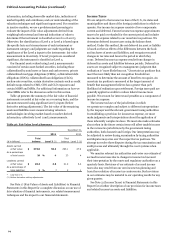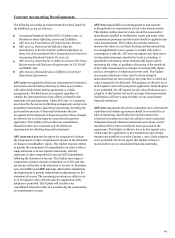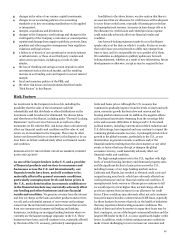Wells Fargo 2011 Annual Report Download - page 90
Download and view the complete annual report
Please find page 90 of the 2011 Wells Fargo annual report below. You can navigate through the pages in the report by either clicking on the pages listed below, or by using the keyword search tool below to find specific information within the annual report.
Regulatory Reform (continued)
The Collins Amendment. This provision of the Dodd-Frank
Act will phase out the benefit of issuing trust preferred
securities by eliminating them from Tier 1 capital over three
years beginning January 2013. We redeemed $9.2 billion of
our trust preferred securities in 2011 as discussed in the
“Capital Management” section of this Report.
Enhanced supervision and regulation of systemically
significant firms. The Dodd-Frank Act grants broad
authority to banking regulators to establish enhanced
supervisory and regulatory requirements for systemically
important firms. In December 2011, the FRB published
proposed rules that would establish enhanced risk-based
capital requirements and leverage limits, liquidity
requirements, counterparty credit exposure limits, risk
management requirements, stress testing requirements,
debt-to-equity limits, and early remediation requirements for
large BHCs like Wells Fargo. The Dodd-Frank Act also
establishes the Financial Services Oversight Council and the
Office of Financial Research, which may recommend new
systemic risk management requirements and require new
reporting of systemic risks.
Establishment of the Consumer Financial Protection Bureau
(CFPB).The Dodd-Frank Act established the CFPB, which
became operational on July 21, 2011. The role of the CFPB is
to ensure consumers get clear, accurate information to
effectively evaluate mortgages, credit cards and other
financial products and protect them from hidden fees,
abusive terms and deceptive practices. The CFPB has broad
rulemaking powers and supervisory and enforcement
authority over consumer financial products and services. The
CFPB has begun exercising its supervisory authority over the
banks under its jurisdiction, including Wells Fargo, and is
preparing for supervision of certain non-bank entities. The
CFPB has indicated it will concentrate much of its
rulemaking effort in 2012 on the variety of mortgage-related
topics required under the Dodd-Frank Act, including the
steering of consumers to certain products, discrimination,
abusive or unfair lending practices, predatory lending,
origination disclosures, minimum mortgage underwriting
standards, and servicing practices. The CFPB has published
proposed regulations on several of these topics, including
minimum mortgage underwriting standards (ability to
repay). At this time, the Company cannot predict the content
of final CFPB regulations and impacts on our business
practices or financial results.
Regulatory Capital Guidelines and Capital Plans
In December 2010, the BCBS finalized Basel III for determining
regulatory capital. When fully phased in by 2019, the Basel III
standards will require BHCs to maintain a minimum ratio of
Tier 1 common equity to risk-weighted assets of at least 7.0%. In
November 2011, the BCBS released its final rule for a common
equity surcharge on certain designated G-SIBs. We have been
named as one of the G-SIBs that will be subject to a surcharge,
although the amount of the surcharge, ranging from 1.0% to
3.5%, has not been determined. The FRB has indicated it expects
to adopt regulations implementing the G-SIB surcharge in 2014
and that the surcharge would be imposed on a phased-in basis
from 2016-2019. In late 2011, the FRB finalized rules to require
BHCs with $50 billion or more of consolidated assets to submit
capital plans annually and to obtain regulatory approval before
making capital distributions. The rule also requires a capital
adequacy assessment under a range of expected and stress
scenarios. For additional information, see the “Capital
Management” section of this Report.
“Living Will” Requirements
In late 2011 the FRB and the FDIC approved final resolution-
plan regulations as mandated by the Dodd-Frank Act. These
regulations will require large financial institutions, including
Wells Fargo, to prepare and periodically revise plans that would
facilitate their resolution in the event of material distress or
failure. As contemplated by the Dodd-Frank Act, resolution
plans are to provide for a rapid and orderly resolution –
liquidation or orderly restructuring – under Bankruptcy Code
and other insolvency statutes applicable to particular types of
regulated entities (such as securities broker-dealers or insurance
companies).
88


